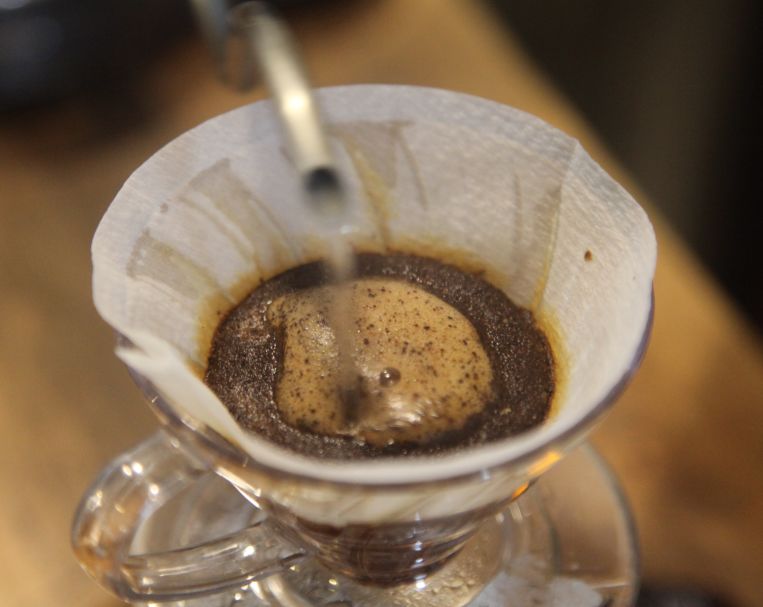Every coffee bean needs to be screened, graded and tested. Why?

Professional coffee knowledge exchange more coffee bean information please follow the coffee workshop (Wechat official account cafe_style)
Ochratoxin A (Ochratoxin A) is a secondary metabolite secreted by Penicillium and Aspergillus. It has nephrotoxicity, immunosuppression, carcinogenicity and so on. Ochratoxin is ubiquitous in nature, in which soybeans, peanuts, corn, coffee beans and other agricultural products are easily contaminated by ochratoxin if they are not preserved properly in a high-temperature and humid environment. Ochratoxin accumulates in the human body, may cause kidney, liver and other diseases. Therefore, if there are people who often drink a lot of coffee, you should pay special attention to it.
However, from the coffee bean processing process, the coffee fruit after processing to the raw bean water content is only 12%, and the roasted ripe beans, the moisture content is less than 5%, stored in the dry state, not easy to mildew. However, if coffee beans are damp or improperly stored during shipping, there is still a risk of ochratoxin production.
The large domestic coffee importers all have coffee storage space, and the warehouse where a large number of raw beans are stored is at least three stories high, the purpose is to maintain good ventilation, and in case of rainy season, there are special personnel responsible for maintaining storage humidity and maintaining the quality of coffee beans.
As for the problem of pesticide residues in coffee beans, most of them are poor and backward countries, the application of pesticides by farmers is not in line with economic benefits, and the probability of pesticide residues in coffee fruits after processing is very low. According to the results of coffee sampling tests conducted by the Food and Drug Department over the years, the failure rate is very low.
However, some people in the coffee industry have revealed that the coffee border inspection is a "sampling", not batch-by-batch inspection, and it is still possible to drink defective beans with bad luck. Therefore, after buying raw beans, many operators will conduct manual screening before baking to ensure the quality of the beans. Some people may even think that the bulk commercial coffee beans that have not been manually screened are more likely to be mixed with defective beans and the quality is relatively poor.
The concept of "picking beans by hand is good coffee" does not apply to the general public. Generally speaking, coffee that needs to pick beans manually is usually tasted as fine coffee produced in small quantities, as well as coffee used for testing when participating in coffee competitions. In general, coffee beans are "graded" (grading) according to their origin, factory height, particle size and the number of imperfections in the sample (including broken beans, pebbles or branches, etc.).
And now the automatic screening of coffee beans has improved from the use of infrared identification to the color sorting machine. After the raw beans enter the guide trough, the color selection machine will blow out the defective beans that do not conform to the color setting from the bean stream, and the beans that have been selected by color will also be screened manually through the conveyor belt to pick out obvious defective beans. Therefore, when selecting beans, manufacturers only need to confirm whether the sample beans meet the classification, because the graded beans naturally have the corresponding quality, and there is no need to worry too much when baking and drinking them later.
Important Notice :
前街咖啡 FrontStreet Coffee has moved to new addredd:
FrontStreet Coffee Address: 315,Donghua East Road,GuangZhou
Tel:020 38364473
- Prev

How to make foam on coffee? How to make coffee foam? What kind of milk is used to make coffee foam?
Professional coffee knowledge exchange More coffee bean information Please pay attention to coffee workshop (Weixin Official Accounts cafe_style) to steam milk foam, will make the milk temperature gradually rise, once the temperature is too high, will make milk smell, or foam appears rough and dry. When using warm milk, not only the temperature will rise rapidly, but also the stirring time cannot be prolonged, so the production
- Next

Qianjie Coffee hand flushing workshop: how to make "expired" coffee by hand? How to calculate the best flavor period?
Professional coffee knowledge exchange more coffee bean information please follow the coffee workshop (Wechat official account cafe_style) We must have had the experience: coffee has been kept for a long time, do you lose it? Or do you continue to use it and reluctantly drink a cup of insipid coffee? Is the expired coffee irreparable? Next, the editor will share with you today's topic of how to make expired coffee by hand.
Related
- Beginners will see the "Coffee pull flower" guide!
- What is the difference between ice blog purified milk and ordinary milk coffee?
- Why is the Philippines the largest producer of crops in Liberia?
- For coffee extraction, should the fine powder be retained?
- How does extracted espresso fill pressed powder? How much strength does it take to press the powder?
- How to make jasmine cold extract coffee? Is the jasmine + latte good?
- Will this little toy really make the coffee taste better? How does Lily Drip affect coffee extraction?
- Will the action of slapping the filter cup also affect coffee extraction?
- What's the difference between powder-to-water ratio and powder-to-liquid ratio?
- What is the Ethiopian local species? What does it have to do with Heirloom native species?

